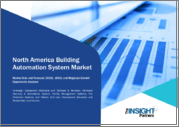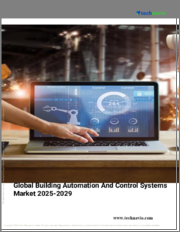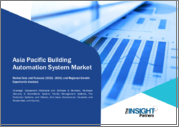
|
시장보고서
상품코드
1504180
빌딩 자동화 시장 규모, 점유율, 예측 및 동향 분석 : 제품별, 기술별, 분야별, 분야별, 지역별 - 세계 전망(-2031년)Building Automation Market Size, Share, Forecast, & Trends Analysis by Offering, Technology, Sector, and Geography - Global Forecast to 2031 |
||||||
빌딩 자동화 시장은 2024-2031년간 10.2%의 연평균 복합 성장률(CAGR)로 성장하여 2031년에는 2,271억 달러에 달할 것으로 예상됩니다.
이 보고서는 주요 5개 지역의 빌딩 자동화 시장을 상세하게 분석했으며, 현재 시장 동향, 시장 규모, 시장 점유율, 최근 동향, 2031년까지의 예측 등의 정보를 정리하여 전해드립니다.
빌딩 자동화 시장의 성장은 상업용 건물과 주거용 건물의 보안 및 모니터링 시스템 도입 증가, 빌딩 자동화 시스템에 IoT 기술의 통합, 에너지 절약 건물에 대한 수요 증가, 건물 내 연결된 장치 수 증가에 의해 주도되고 있습니다. 그러나 높은 도입 비용은 이 시장의 성장을 저해하는 요인으로 작용하고 있습니다.
또한, 스마트 시티의 확산, 건물 에너지 효율을 높이기 위한 정부의 이니셔티브 증가, 빌딩 자동화 시스템에 대한 무선 기술 도입 증가는 이 시장의 이해 관계자들에게 성장 기회를 제공할 것으로 예상됩니다. 그러나 표준화된 통신 프로토콜의 부재와 숙련된 전문가의 부족은 빌딩 자동화 시장의 성장에 영향을 미치는 주요 과제입니다.
목차
제1장 서론
제2장 조사 방법
제3장 주요 요약
제4장 시장 인사이트
- 개요
- 성장 촉진요인
- 성장 억제요인
- 기회
- 과제
- 주요 동향
- 사례 연구
- Porter의 Five Forces 분석
- 밸류체인 분석
제5장 빌딩 자동화 시장 : 제공 제품별 평가
- 개요
- HVAC 시스템
- 보안 및 입퇴실 관리 시스템
- 에너지 관리 시스템
- 물관리 시스템
- 조명 시스템
- 방화 시스템
- 시설 관리 시스템
- 빌딩 자동화 서비스
- 기타 서비스
제6장 빌딩 자동화 시장 : 기술별 평가
- 개요
- 유선 기술
- 무선 기술
- Zigbee
- Wi-Fi
- Bluetooth
- Z-Wave
- 기타 무선 기술
제7장 빌딩 자동화 시장 : 부문별 평가
- 개요
- 주택
- 상업
- 산업
제8장 빌딩 자동화 시장 : 지역별
- 개요
- 북미
- 미국
- 캐나다
- 유럽
- 독일
- 영국
- 프랑스
- 이탈리아
- 스페인
- 덴마크
- 스웨덴
- 기타 유럽
- 아시아태평양
- 일본
- 중국
- 인도
- 한국
- 싱가포르
- 대만
- 기타 아시아태평양
- 라틴아메리카
- 멕시코
- 브라질
- 기타 라틴아메리카
- 중동 및 아프리카
- 아랍에미리트(UAE)
- 이스라엘
- 기타 중동 및 아프리카
제9장 경쟁 분석
- 개요
- 주요 성장 전략
- 경쟁 벤치마킹
- 경쟁 대시보드
- 업계 리더
- 시장 차별화 요인
- 선행 기업
- 신규 기업
- 시장 점유율 분석
제10장 기업 개요(기업 개요, 재무 개요, 제품 포트폴리오, 전략적 전개)
- Siemens AG
- Honeywell International Inc.
- ABB Ltd.
- Schneider Electric SE
- Johnson Controls International plc
- Cisco Systems, Inc.
- Huawei Technologies Co., Ltd.
- Robert Bosch GmbH
- Legrand
- Delta Electronics, Inc.
- Hubbell Incorporated
- Trane Technologies plc
- Lutron Electronics Co., Inc
- Mitsubishi Electric Corporation
- Crestron Electronics, Inc.
(주 : 주요 5개사의 SWOT 분석을 제공)
제11장 부록
LSH 24.07.09Building Automation Market by Offering (HVAC Systems, Security & Access Control Systems, Lighting Systems, Energy Management Systems), Technology (Wired, Wireless), Sector (Residential, Commercial), and Geography-Global Forecast to 2031.
The research report titled 'Building Automation Market by Offering (HVAC Systems, Security & Access Control Systems, Lighting Systems, Energy Management Systems), Technology (Wired, Wireless), Sector (Residential, Commercial), and Geography-Global Forecast to 2031' provides an in-depth analysis of the building automation market in five major geographies and emphasizes on the current market trends, market sizes, market shares, recent developments, and forecasts till 2031.
The building automation market is projected to reach $227.1 billion by 2031, at a CAGR of 10.2% from 2024 to 2031.
The growth of the building automation market is driven by the increasing deployment of security & surveillance systems in commercial & residential buildings, the integration of IoT technologies into building automation systems, the increasing demand for energy-efficient buildings, and the rising number of connected devices in buildings. However, the high cost of implementation restrains the growth of this market.
Furthermore, the proliferation of smart cities, increasing government initiatives to enhance energy efficiency in buildings, and increasing deployment of wireless technology in building automation systems are expected to generate growth opportunities for the stakeholders in this market. However, the lack of standardized communication protocols and the shortage of skilled professionals are major challenges impacting the growth of the building automation market.
The building automation market is segmented by offering (HVAC systems, security & access control systems, energy management systems, water management systems, lighting systems, fire protection systems, facility management systems, building automation system services, and other offerings), technology (wired technology, wireless technology (Zigbee, Wi-Fi, Bluetooth, z-wave)), sector (residential, commercial, industrial). The study also evaluates industry competitors and analyzes the market at the regional and country levels.
Based on offering, the building automation market is segmented into HVAC systems, security & access control systems, energy management systems, water management systems, lighting systems, fire protection systems, facility management systems, building automation system services, and other offerings. In 2024, the HVAC systems segment is expected to account for the largest share of above 30% of the building automation market. The large market share of this segment is attributed to the increasingly concerned about environmental impact, increasing urbanization, technological advancements in HVAC systems, and increasing implementation of stricter regulations for air quality in commercial buildings. In July 2022, Fr. Sauter AG (Switzerland) launched IoT-capable actuators to enable autonomous or semi-autonomous control in heating, ventilation, and air conditioning systems for modernized buildings.
However, the security & access control systems segment is projected to register the highest CAGR during the forecast period. The segment's growth is attributed to the advancements in biometric technologies, increasing security concerns in the commercial sector, and increasing deployment of security solutions by building owners to protect occupants, assets, and sensitive information. In March 2023, Johnson Controls International plc (Ireland) launched IQ Pro Hybrid Security Panel, a life safety and security device for intrusion protection in commercial buildings, large residential facilities, campuses, and K-12 markets.
Based on technology, the building automation market is segmented into wired and wireless technology. In 2024, the wired technology segment is expected to account for the largest share of above 65% of the building automation market. The large market share of this segment is attributed to the growing demand for wired solutions for fire alarms and security control systems and changing consumer preference for stable & reliable wired systems for building automation. Wired connections provide significantly lower latency for applications requiring real-time data and immediate response, such as HVAC systems and building automation controls.
However, the wireless technology segment is projected to register the highest CAGR during the forecast period. The segment's growth is attributed to the increasing demand for wireless technology to reduce installation time and cost, increasing adoption of cloud-based solutions, and increasing adoption of wireless technology for various applications such as lighting, security and access control, elevator management, and energy management in buildings.
Based on sector, the building automation market is segmented into residential, commercial, and industrial. In 2024, the commercial segment is expected to account for the largest share of above 40% of the building automation market. The large market share of this segment is attributed to the increasing government implementation of stricter regulations on energy efficiency in commercial buildings, advancements in sensor technology, cloud computing, and the Internet of Things (IoT), increasing building automation for cost savings and improve operational efficiency to enhanced tenant satisfaction, and increasing use of biometric technology for security and access controls in commercial buildings. In April 2023, 75F, Inc. (U.S.) launched a new range of innovative products and solutions to improve building efficiency, enhance indoor air quality, and reduce operating costs in commercial buildings.
However, the residential segment is projected to register the highest CAGR during the forecast period. The segment's growth is attributed to the rising sense of home safety & security, the growing need for IoT security solutions in the residential sector, the increasing popularity of smart devices, and changing consumer preferences for a convenient and comfortable living experience. In March 2024, Hangzhou Hikvision Digital Technology Co., Ltd. (China) partnered with Can'nX (France) to integrate AI-enabled devices, such as cameras, into building systems and offer automation solutions for commercial and residential buildings.
Based on geography, the building automation market is segmented into North America, Europe, Asia-Pacific, Latin America, and the Middle East & Africa. In 2024, North America is expected to account for the largest share of above 35% of the building automation market. The market growth in North America is driven by the higher adoption rate for advanced technologies, the presence of established players in the region, the increasing adoption of smart devices for commercial and residential applications, and the increasing adoption of energy-efficient solutions for building management. North America is focusing on reducing its carbon footprint and building automation helps to optimize energy consumption. Government bodies in the region have implemented stricter regulations on energy efficiency in buildings. Market players are also focusing on offering automation solutions for energy efficiency and security applications. For instance, in April 2024, Johnson Controls International plc (Ireland) launched a Security Operations Centers (SOC) service in the North American market to create safer and more productive environments for commercial buildings.
However, Asia-Pacific is projected to record the highest CAGR of above 12% during the forecast period. The region's growth is attributed to the surge in government initiatives to promote energy-efficient building systems, an increasing number of smart city projects, and increasing government investments in public infrastructure. The region is experiencing rapid urbanization with a surge in new buildings, opening new opportunities for integrating building automation systems. With a growing population and rising energy demands, government bodies across the region are prioritizing energy-efficient buildings.
The key players operating in the building automation market are Siemens AG (Germany), Honeywell International Inc. (U.S.), ABB Ltd. (Switzerland), Schneider Electric SE (France), Johnson Controls International plc (Ireland), Cisco Systems, Inc. (U.S.), Huawei Technologies Co., Ltd. (China), Robert Bosch GmbH (Germany), Legrand (France), Delta Electronics, Inc. (Taiwan), Hubbell Incorporated (U.S.), Trane Technologies plc (Ireland), Lutron Electronics Co., Inc (U.S.), Mitsubishi Electric Corporation (Japan), and Crestron Electronics, Inc. (U.S.).
Key Questions Answered in the Report:
- What are the high-growth market segments in terms of the offering, technology, and sector?
- What is the historical market size for building automation?
- What are the market forecasts and estimates for 2024-2031?
- What are the major drivers, restraints, opportunities, challenges, and trends in the building automation market?
- Who are the major players in the building automation market, and what are their market shares?
- What is the competitive landscape like?
- What are the recent developments in the building automation market?
- What are the different strategies adopted by major market players?
- What are the trends and high-growth countries?
- Who are the local emerging players in the building automation market, and how do they compete with other players?
Scope of the Report:
Building Automation Market Assessment-by Offering
- HVAC Systems
- Security & Access Control Systems
- Energy Management Systems
- Water Management Systems
- Lighting Systems
- Fire Protection Systems
- Facility Management Systems
- Building Automation System Services
- Other Offerings
Building Automation Market Assessment-by Technology
- Wired Technology
- Wireless Technology
- Zigbee
- Wi-Fi
- Bluetooth
- Z-Wave
- Other Wireless Technologies
Building Automation Market Assessment-by Sector
- Residential
- Commercial
- Industrial
Building Automation Market Assessment-by Geography
- North America
- U.S.
- Canada
- Europe
- Germany
- U.K.
- France
- Italy
- Spain
- Denmark
- Sweden
- Rest of Europe
- Asia-Pacific
- Japan
- China
- India
- South Korea
- Singapore
- Taiwan
- Rest of Asia-Pacific
- Latin America
- Mexico
- Brazil
- Rest of Latin America
- Middle East & Africa
- UAE
- Israel
- Rest of Middle East & Africa
TABLE OF CONTENTS
1. Introduction
- 1.1. Market Definition & Scope
- 1.2. Currency & Limitations
- 1.2.1. Currency
- 1.2.2. Limitations
2. Research Methodology
- 2.1. Research Approach
- 2.2. Data Collection & Validation Process
- 2.2.1. Secondary Research
- 2.2.2. Primary Research/Interviews with Key Opinion Leaders of the Industry
- 2.3. Market Sizing and Forecasting
- 2.3.1. Market Size Estimation Approach
- 2.3.2. Growth Forecast Approach
- 2.4. Assumptions for the Study
3. Executive Summary
- 3.1. Overview
- 3.2. Market Analysis, By Offering
- 3.3. Market Analysis, By Technology
- 3.4. Market Analysis, By Sector
- 3.5. Market Analysis, By Geography
- 3.6. Competitive Analysis
4. Market Insights
- 4.1. Overview
- 4.2. Factors Affecting Market Growth
- 4.2.1. Drivers
- 4.2.1.1. Increasing Deployment of Security & Surveillance Systems in Commercial & Residential Buildings
- 4.2.1.2. Integration of IoT Technologies into Building Automation Systems
- 4.2.1.3. Increasing Demand for Energy-efficient Buildings
- 4.2.1.4. Rising Number of Connected Devices in Buildings
- 4.2.2. Restraints
- 4.2.2.1. High Cost of Implementation
- 4.2.3. Opportunities
- 4.2.3.1. Proliferation of Smart Cities
- 4.2.3.2. Increasing Government Initiatives to Enhance Energy Efficiency in Buildings
- 4.2.3.3. Increasing Deployment of Wireless Technology in Building Automation Systems
- 4.2.4. Challenges
- 4.2.4.1. Lack of Standardized Communication Protocols
- 4.2.4.2. Shortage of Skilled Professionals
- 4.2.1. Drivers
- 4.3. Key Trends
- 4.3.1. Use of 5G Technology to Boost Internet Connectivity
- 4.3.2. Integration of AI in Building Automation Systems
- 4.4. Case Studies
- 4.5. Porter's Five Forces Analysis
- 4.6. Value Chain Analysis
5. Building Automation Market Assessment-by Offering
- 5.1. Overview
- 5.2. HVAC Systems
- 5.3. Security & Access Control Systems
- 5.4. Energy Management Systems
- 5.5. Water Management Systems
- 5.6. Lighting Systems
- 5.7. Fire Protection Systems
- 5.8. Facility Management Systems
- 5.9. Building Automation Services
- 5.10. Other Offerings
6. Building Automation Market Assessment-by Technology
- 6.1. Overview
- 6.2. Wired Technology
- 6.3. Wireless Technology
- 6.3.1. Zigbee
- 6.3.2. Wi-Fi
- 6.3.3. Bluetooth
- 6.3.4. Z-Wave
- 6.3.5. Other Wireless Technologies
7. Building Automation Market Assessment-by Sector
- 7.1. Overview
- 7.2. Residential
- 7.3. Commercial
- 7.4. Industrial
8. Building Automation Market-by Geography
- 8.1. Overview
- 8.2. North America
- 8.2.1. U.S.
- 8.2.2. Canada
- 8.3. Europe
- 8.3.1. Germany
- 8.3.2. U.K.
- 8.3.3. France
- 8.3.4. Italy
- 8.3.5. Spain
- 8.3.6. Denmark
- 8.3.7. Sweden
- 8.3.8. Rest of Europe
- 8.4. Asia-Pacific
- 8.4.1. Japan
- 8.4.2. China
- 8.4.3. India
- 8.4.4. South Korea
- 8.4.5. Singapore
- 8.4.6. Taiwan
- 8.4.7. Rest of Asia-Pacific
- 8.5. Latin America
- 8.5.1. Mexico
- 8.5.2. Brazil
- 8.5.3. Rest of Latin America
- 8.6. Middle East & Africa
- 8.6.1. UAE
- 8.6.2. Israel
- 8.6.3. Rest of Middle East & Africa
9. Competition Analysis
- 9.1. Overview
- 9.2. Key Growth Strategies
- 9.3. Competitive Benchmarking
- 9.4. Competitive Dashboard
- 9.4.1. Industry Leaders
- 9.4.2. Market Differentiators
- 9.4.3. Vanguards
- 9.4.4. Emerging Companies
- 9.5. Market Share Analysis
10. Company Profiles (Company Overview, Financial Overview, Product Portfolio, and Strategic Developments)
- 10.1. Siemens AG
- 10.2. Honeywell International Inc.
- 10.3. ABB Ltd.
- 10.4. Schneider Electric SE
- 10.5. Johnson Controls International plc
- 10.6. Cisco Systems, Inc.
- 10.7. Huawei Technologies Co., Ltd.
- 10.8. Robert Bosch GmbH
- 10.9. Legrand
- 10.10. Delta Electronics, Inc.
- 10.11. Hubbell Incorporated
- 10.12. Trane Technologies plc
- 10.13. Lutron Electronics Co., Inc
- 10.14. Mitsubishi Electric Corporation
- 10.15. Crestron Electronics, Inc.
(Note: SWOT analysis of the top 5 companies will be provided.)
11. Appendix
- 11.1. Available Customization
- 11.2. Related Reports



















